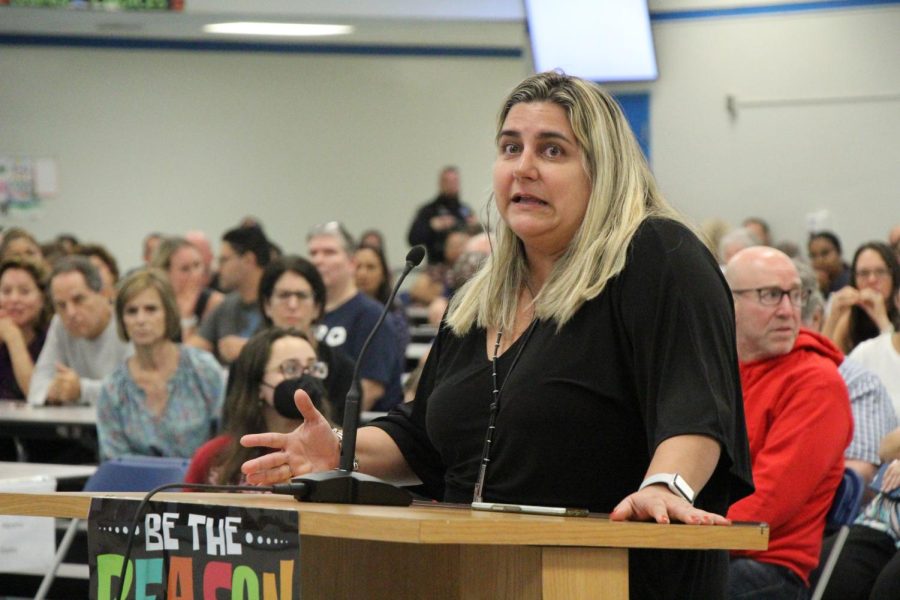Your donation will support the student journalists of Marjory Stoneman Douglas High School. Your contribution will allow us to purchase equipment and cover our annual website hosting costs.
Boundary Considerations
December 14, 2022
Speaking Sides. Elainey Carvallio expresses her concerns at the Nov. 3 boundary meeting about removing MSD students from the school boundary before the district completes a process to remove students attending MSD through falsified addresses.
When weighing proposals, the BCPS Demographics and Enrollment Planning Department looks at several factors: class size impact, school concurrency level of service impact, enrollment, diversity, feeder patterns, school proximity impact, which includes transportation and 2-mile walk boundary, neighborhood integrity and natural barrier impacts. However, not all are relevant to MSD’s specific situation.
At the Nov. 3 meetings, parents made impassioned speeches in support of or against specific proposals. Community members could also leave public comments on the proposals online at the district’s website until Nov. 14.
“…There is only one map that meets all eight considerations. That map is C-1; it meets the class size impact, it meets the school concurrency level of service impact, it meets the enrollment impact, it also meets the diversity impact,” Parkland community member Kevin Hagens said at the Nov. 3 meeting. “Not only does it meet the diversity impact, it has the least aggregate impact on diversity out of all of the maps. C-1 is the only map that does not affect feeder patterns… every student moved under C-1 would be closer to Coral Glades than they would to MSD… so in light of the considerations that the school board has put forth, I think this is the map clearly that meets all of those when we are looking at this decision I think we keep those in mind.”
While class size impact is normally very important for boundary changes, MSD is currently meeting all class size requirements, according to Beck. All core classes are capped at 25 students.
Important factors in MSD’s boundary proposals include that the proposals cannot drastically alter the demographics of the school. BCPS defines drastically as a 5% difference; if a map were to cross this threshold, the school board would need to be notified. This is a newer rule, as previously, diversity was not counted and resulted in “wacky” and “insidious” proposals, according to Beck.
According to Demographics and Enrollment Planning Department, none of the proposals reduce diversity by over 5%.
“MSD has 439 Black students. By removing TAZ 107, 112 and 653 [in southern Coral Springs], the school is losing 98 Black students, 22% of the entire Black student population. [This is] not okay, not representative of Broward County’s diversity nor the schools in northwest Broward,” Coral Springs resident Jennifer Levi said at the Nov. 3 meeting. “…I know that the diversity impact comes into play…at 5%. However, with a school so minimally diverse as MSD, they can’t afford to lose any more diversity.”
Feeder patterns are the percentage of students that stay together from elementary school to middle school to high school. The idea is to allow students to stay together with their peers throughout elementary school to middle school to high school. For example, the feeder pattern for TAZ 49, located in East Parkland, follows the feeder pattern of Riverglades Elementary School to Westglades Middle School to MSD. The school board must be notified of a change to the feeder pattern.
Several proposals break the feeder patterns, including C-2, C-3, C-4, C-7, C-8, C-13 and C-15.
School proximity impact is another consideration weighed when adopting a new boundary; it examines if students in the affected areas will now have to travel farther to go to school.
One important consideration is whether a proposal removes students from within a 2-mile walking distance and places them at a school farther away, where walking is no longer an option. All BCPS schools have an identified 2-mile walking radius; students outside that are eligible to receive bus transportation to their school. Sending students to a school further away increases transportation costs for BCPS.
Proposals C-8 and C-15 would both remove students from TAZ 56, which is the neighborhood of Wyndham Lakes. Parts of TAZ 56 are included in the 2-mile walk radius of MSD. If moved, students living there would need to be bussed to their new school, Coral Glades High School.
C-2 removes all TAZs below Coral Hills Drive, which includes TAZs 107, 653 and 112. Students that live north of Sample Road, in TAZ 107, are closer to MSD than the proposed rezoned school: Coral Glades High School.
BCPS attempts to avoid splitting neighborhoods in half. Several proposals have had to be altered due to this consideration, which is called neighborhood integrity. C-2 splits The Hills in Coral Springs, and the proposer of the map is aware of this. C-7 splits Pine Tree Estates in East Parkland, though the neighborhood is large and spans three TAZs. C-12 also splits a neighborhood.
The natural barrier impact takes into account where there is a potential hazard that would allow students to qualify for a bus. This is more relevant to elementary school students, but the Demographics and Enrollment Planning Department did note the Sawgrass Expressway.
